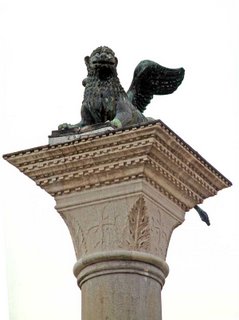89. The 'Lion' of St. Mark
 The Gospel according to St. Mark describes John the Baptist preaching "like a lion roaring". Perhaps because of this, the evangelistic symbol for St Mark is a lion. All of the four gospel authors have a symbolic creature associated with them – Matthew's is a man, symbolizing the human nature of Christ; Luke has a bull or calf, symbolizing the sacrifice of Christ; John's symbol is an eagle, for the omnipotent all-seeing eye of God. Mark's lion symbolizes Christ as king.
The Gospel according to St. Mark describes John the Baptist preaching "like a lion roaring". Perhaps because of this, the evangelistic symbol for St Mark is a lion. All of the four gospel authors have a symbolic creature associated with them – Matthew's is a man, symbolizing the human nature of Christ; Luke has a bull or calf, symbolizing the sacrifice of Christ; John's symbol is an eagle, for the omnipotent all-seeing eye of God. Mark's lion symbolizes Christ as king.All four of these creatures are traditionally depicted with wings, which creates some confusion in many people's minds about whether Matthew's is supposed to be a man or an angel, but it does explain why there are winged lions all over St. Mark's Venice in the form of sculptures and reliefs and paintings and mosaics – even doorknobs and restaurant menus.
This 3-ton bronze sculpture perched atop a massive granite column in the Piazetta is the most important and most famous of all the winged lion representations in the city, yet it is one of the strangest. Although it depicts a suitably strong and fierce animal, and although its body is sort of leonine, it would be hard to recognize its head in any other context as being any sort of cat at all, let alone Leo, the king of the jungle.
This is not surprising when you realize that the head and body of this animal are not of a lion at all but of some sort of completely mythical beast. Art historians usually describe this work as being a Chinese or Persian 'chimera', but nobody knows for sure where or when it was made. Perhaps it was captured during the sacking of Constantinople, perhaps some Venetian traders acquired it, but there is no record of how it came to be in Venice.
The wings are also not original. They were probably made in Venice, and then tacked on to this bizarre creature's back to create a 'winged lion', shown with his paws on an open copy of St. Mark's gospel.
This huge granite column - one of a pair - was definitely 'souvenired' from Constantinople in 1204 during the disastrous Fourth Crusade, and this odd but very heavy hybrid sculpture was hoisted to the top of it sometime later, probably early in the 13th century – no mean feat in itself when you think about it.

1 Comments:
im a student in singapore and my class refers to ur blog as a guide for our understanding on the chapter RISE OF VENICE. so dont stop writing, cause i, i mean WE[my class] LOVEEE ur BLOG
Post a Comment
<< Home